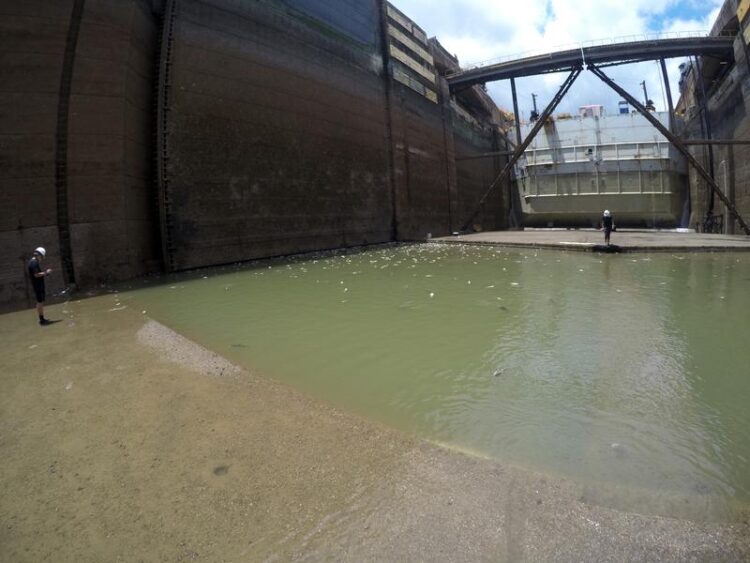Suez and Panama Canals as hotspots for invasive alien species

Sampling fish at the Panama Canal Miraflores locks
Gustavo Castellanos-Galindo
Leibniz Centre for Tropical Marine Research
Invasive alien species are one of the main threats to the biodiversity of natural habitats worldwide. They can cause severe ecological and economic damage and can be a root of biodiversity loss. Artificial man-built maritime canals have long been known as hotspots for invasion by various types of marine organisms.
Scientists from the Leibniz Centre for Tropical Marine Research (ZMT) and the Smithsonian Tropical Research Institute in Panama have now detected changes in the salinity of Lake Gatún, an artificial fresh-water reservoir, which was built during the development of the Panama Canal.
A 29 km long section of the Panama Canal leads through Lake Gatún, and that has so far prevented most marine species from successfully crossing the canal. A brackish Lake Gatún could imply that in future hundreds of fish species tolerant to low salinities might be able to master the journey from the Pacific to the Caribbean Sea and vice versa through the Panama Canal, the researchers write in the journal Nature Ecology & Evolution.
“The expansion of the Panama Canal, which was completed in 2016, is changing the conditions that make Lake Gatún a successful barrier”, explains first author Dr. Gustavo Castellanos-Galindo of ZMT. “With the expansion larger locks were built to allow the passage of bigger ships that were not able to pass through the original locks from 1914.”
Castellanos-Galindo says that the new lock design which incorporates recirculation of some lockage water as well as increased ship traffic and lock usage could be letting more saltwater into the lake making it slightly brackish. “In future this change could enable some marine species to pass through the lake and thus from one ocean to the other”, the researcher adds. „Faunas that have been separated for millions of years would be mixed and the ecological and socio-economic consequences of this exchange are currently difficult to predict, but in the past we have already seen similar phenomena in the Suez Canal.”
Since its opening in 1869, the Suez Canal has led to the introduction of more than 100 marine fish species from the Red Sea to the Mediterranean, most recently the venomous lionfish, a process which scientists refer to as Lessepsian migrations, named after Ferdinand de Lesseps, the French developer of the Suez Canal.
“Following the construction of an additional 35 kilometres of canal, which became operational in 2015, an increase in Red Sea fish species has been observed in the Mediterranean,” reports Castellanos-Galindo. “The progressive ‘tropicalisation’ of the Mediterranean Sea with rising water temperatures due to climate change means that migrant fish species from the Red Sea that are accustomed to warmer waters could in the long term find more favourable conditions to thrive in the new Mediterranean environment.”
The scientists are concerned about these developments and recommend using scientific tools to guide management in both global shipping policy and local efforts to prevent invasive alien species from entering new habitats through channels. “Scientific tools such as environmental DNA measurements could be methods to detect invasions at the early stages”, suggests Castellanos-Galindo, “or deterrents such as acoustic technology could be introduced to prevent fish passage through the locks of these canals.”
United Nations agendas, such as the sustainable development goal SDG 15 ‘Life on Land’, set targets to both conserve biodiversity and prevent the introduction of invasive alien species. Castellanos-Galindo also hopes that the UN Decade of the Oceans (2021-2030) will provide a good opportunity to “further accelerate science and management to curb the spread of invasive alien species through shipping channels.”
The fish ecologist says: “From a scientific point of view, it is important to understand the mechanisms involved in invasions and in designing possible prevention and containment measures. Policy and management measures at local and regional level can further help to reduce the risk posed by invasive alien species on these important trade routes.”
Wissenschaftliche Ansprechpartner:
Dr. Gustavo Castellanos-Galindo | Working group Resource Management
Leibniz Centre for Tropical Marine Research (ZMT)
E-Mail: gustavo.castellanos@leibniz-zmt.de
Originalpublikation:
Castellanos-Galindo GA, Robertson DR, Torchin ME (2020) A new wave of marine fish invasions through major shipping canals. Nature Ecology and Evolution. DOI: 10.1038/s41559-020-01301-2
Link to article on-line: https://rdcu.be/b6Dp4
Media Contact
All latest news from the category: Ecology, The Environment and Conservation
This complex theme deals primarily with interactions between organisms and the environmental factors that impact them, but to a greater extent between individual inanimate environmental factors.
innovations-report offers informative reports and articles on topics such as climate protection, landscape conservation, ecological systems, wildlife and nature parks and ecosystem efficiency and balance.
Newest articles

Scientists transform blood into regenerative materials
… paving the way for personalized, blood-based, 3D-printed implants. Scientists have created a new ‘biocooperative’ material based on blood, which has shown to successfully repair bones, paving the way for…

A new experimental infection model in flies
…offers a fast and cost-effective way to test drugs. Researchers at the Germans Trias i Pujol Research Institute and Hospital have reinforced their leading role in infectious disease research by…

Material developed with novel stretching properties
KIT researchers produce metamaterial with different extension and compression properties than conventional materials. With this material, the working group headed by Professor Martin Wegener at KIT’s Institute of Applied Physics…



